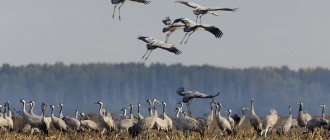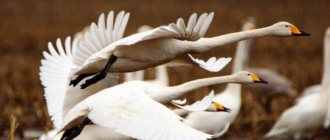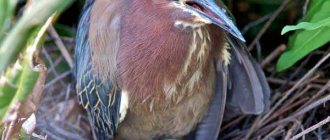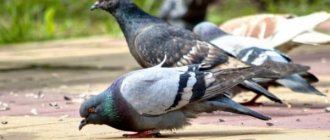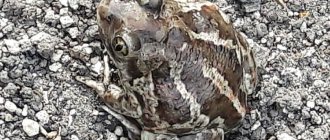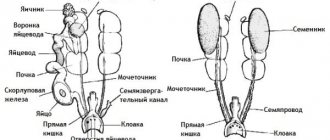Where do wild swans live?
Swans live on the continent of Eurasia, Australia, South America and North America. They live near bodies of water. Moreover, the size of the reservoir does not matter much. They can live both on small lakes and on the shores of seas and estuaries.
Interesting materials:
How to delete a file? How to remove files from NOD32 quarantine? How to uncheck print to file? How to remove the select a file for preview column? How to remove printing from a file in Word? How to remove the latest files from Windows 10? How to remove In a folder, select a file to preview? How to organize files in a folder by month? How to install files to another drive? How to install CRX file in Chrome?
Bird categories
Depending on the species, these birds can be migratory, partially migratory, or remain in their habitat for the entire winter season.
Therefore, they can be divided into the following categories:
- Migratory group - trumpeters with white plumage, tundra analogues, American, black subspecies, South American birds of this type fly south.
- Partially migratory birds are whoopers and mute birds with white feathers.
- Birds that winter in their habitats are Australian birds of this species.
The last group can also include birds of this class that have received an injury that does not allow them to migrate and swans that remained in their main habitat due to mild climatic conditions in winter.
Where do cranes winter?
The wintering grounds of gray cranes lie in the south of Western Europe, North Africa, Western Asia, India and China. Cranes living in the north of the European part, Scandinavia and the Baltic countries fly to France, Spain, Egypt and Sudan for the winter.
Interesting materials:
What does the name Tamara mean and where did it come from? What does the name Tamara mean in Arabic? What does the name Tamara mean in Japanese? What does the name Varvara mean for a child? What does the name Varvara mean and where did it come from? What does the name Veronica mean for a child? What does the name Veronica mean on Wikipedia? What does the name Victor mean and where did it come from? What does the name Victor Victor mean? What does the name Victor mean?
Reviews from the network
A very important condition for keeping swans in winter is the air temperature. Both cold and too high temperatures can have a negative impact on the health of swans. It is very important to determine the optimal relative humidity. High humidity can cause loss of appetite in swans and also lead to illness. Too dry air will lead to poor heat transfer, the bird will always feel thirsty.
The poultry house must have good ventilation. Otherwise, the air will be very polluted, appetite will decrease, and various respiratory diseases are possible. You also need to follow the recommended planting density - plant 1 adult swan per 1 square meter of floor area. The space for one bird should be fenced off with a net, thus creating unique sections.
There should be a pen located directly next to the premises. In warm weather, swans are walked in it. The poultry house for keeping swans in the winter must have dry and clean bedding. You can use peat, straw, shavings, sawdust, and husks as it. Slaked lime is laid under the bedding, based on the calculation of 0.5-1 kilogram per 1 square meter.
Sensational discovery!
However, on May 21, 1822, a sensation spread around the world! Near Mecklenburg , an 80-centimeter arrow was found in the body of a dead stork, piercing the bird’s neck. The arrow was not from here and belonged to one of the African tribes . A desperate brave man with an arrow in his throat managed to overcome the entire migration route, returning home from the equatorial wintering grounds.
This story shed light on the mysterious disappearance of birds in winter. A stuffed specimen of the famous arrow stork can still be seen in the zoological collection of the University of Rostock.
Repeated reports of white storks with African arrows in their bodies helped make the discovery: European birds winter in equatorial Africa. However, ringing, which naturalists began to carry out since the 90s of the 19th century, made it possible to accurately determine the places where birds fly to for the winter.
At what altitude do birds migrate?
Most songbirds migrate at altitudes of 500–2000 meters. And this is the height of 2-4 Eiffel Towers. Some winged birds rise almost 7 kilometers above the ground. Swans were observed at a distance of 8 kilometers from the ground, and bar-headed geese were observed at an altitude of 9 kilometers above the ground .
Small birds can fly continuously for 70–90 hours, flying four thousand kilometers. Their flight speed is 30 km/h. Large birds migrate at a speed of 80 km/h.
Swans on freezing ponds: everything you need to know about saving birds in winter
The press service of the Kaliningrad Zoo has prepared a memo for city residents, which explains why some swans do not fly away when cold weather sets in, what the birds eat, and in what cases they need human help. With the establishment of frosty weather, the information contained in it again became relevant. “Afisha New Kaliningrad” publishes the entire memo.
Why didn't the swans fly away with their relatives?
"Decreased migratory instinct." This is the scientific name for the reluctance of birds to fly to warmer regions with the onset of cold weather. Scientists see several reasons for this behavior. Firstly, winters in the Kaliningrad region are becoming warmer every year. Reservoirs do not freeze, and swans always have access to their main food - algae. Secondly, swans attract a huge number of people who, with the best intentions, feed them. Naturally, the birds get used to humans and absolutely do not want to part with their “grain places” on city lakes.
By feeding swans, humans do them a disservice. Birds continue to wait for their “breadwinners” even with the onset of severe frosts, but they, as a rule, prefer not to go outside again. The fed birds suffer, but cannot immediately find their bearings and fly to unfrozen bodies of water. As a result, some get sick and even die.
What do swans eat in winter?
The main food of waterfowl is algae. And as long as the reservoir is not frozen, the swans have access to food. With the onset of severe frosts, many swans move to the ice-free sea coast, where they safely feed until spring.
What can you feed swans in winter?
Ideally, it is better not to feed swans at all. But if you are going to feed, then you need to do it in such a way as not to harm the birds.
1. Swans should absolutely not be fed black bread! It causes fermentation in the stomach and, as a result, gastrointestinal upset, weakness, and illness. White bread is acceptable in the absence of other food, but in extremely limited quantities!
2. Swans should absolutely not be fed moldy or sour bread! For birds, as for people, spoiled food is deadly.
3. In cold weather, swans can be fed raw or lightly boiled shredded vegetables: cabbage, carrots, potatoes, as well as steamed rice or millet. However, in severe frost, all this food freezes to the ice. In this case, a grain mixture of wheat, oats and barley or a special feed for birds that does not contain salt is suitable as feed.
The swan's digestive system is designed in such a way that it must wash down its food. Therefore, food should be thrown into the water or onto the shore at the very edge of the water. As a last resort - on the ice.
How can I tell if the birds need my help?
A bird needs human help if: - there are obvious signs of injury or damage, - the bird is lying on the ice, and its plumage is covered with a crust of ice or icicles.
In all other cases, the bird most likely does not need human help. Moreover, swans are able to safely tolerate temperatures down to minus 15 degrees. In this case, the bird spends all its energy on saving energy and maintaining heat. She chooses a safe place on the ice away from the shore, lies down and rests. The worst thing you can do in this situation is to drive her away from her home.
If a bird has fishing line stuck in its beak, don't cut it! A weight or hook can be attached to the fishing line. If you cut the line, it will be impossible to pull it out. In this case, it is better to entrust the release of the bird to veterinarians.
Can I “surrender” a swan to the zoo?
The Kaliningrad Zoo does not accept swans for two reasons. According to Article 4 of the Federal Law “On Fauna,” wild animals and birds are the property of the state. Their extraction from nature is possible only with the consent of the competent government bodies, for example Rosprirodnadzor. In addition, the zoo does not have sufficient space and conditions to support a large number of swans. Especially considering the fact that every year they try to “place” from 10 to 20 birds here.
Where to go for help if a bird is injured?
In the Kaliningrad region there are a number of public, municipal and private organizations that are ready to provide advisory or organizational assistance to those who have found a wounded swan:
— Kaliningrad Zoo, 21-89-14; — Public organization “Baltic Swan”, 8-911-49-04-700; — Shelter “Klyukvennoye 39”, 8-963-29-21-088; — Bird Park “Priozerye”, 8-911-86-57-066; — Private “Compound on Khutorskaya”, 8-911-45-90-460.
Photo — Vitaly Nevar, “New Kaliningrad”
Swan habitat
White individuals prefer to settle in areas where the climate is temperate and in tropical areas. They belong to waterfowl, and therefore live mainly in various types of water bodies. They feed there, in shallow water, on various mollusks, small crustaceans, fish and vegetation.
Most bird species live in the northern hemisphere, the black species lives in Australia and New Zealand. The black-necked swan, or as it is otherwise called the South American swan, is found in fresh waters in the south of South America, where it nested.
Black-necked birds do not live in the following countries:
- Asia;
- Central America;
- Northern regions of South America;
- Africa.
Zoologists note that the whooper species lives on the Eurasian continent, mainly in its northern part. In countries such as Iceland, Scotland, a number of Scandinavian countries, also in the territory from Kamchatka to eastern Sakhalin, on the Black, White and Baltic seas.
The whooper occupies territory mainly on the water. Prefers large lakes that are overgrown with grass, reeds and reeds along the edges of the banks, or on remote lakes in the forest. It happens that they are located on the sea coast in areas overgrown with reeds.
They settle in bodies of water near places where people live. If swans live close to people, they should not be disturbed.
The mute lives further south than the whooper swan. Occupies the southern and central European zone, as well as most of Asia. Mute swans, like other types of swans, are located in remote estuaries and overgrown lakes. Swans are also spotted in the swamps.
Airspeed
The flight speed of birds during migration is relatively low. One of the slowest is the quail - it flies at a speed of approximately 40 km/h ; the black swift is among the fastest (160 km/h). But during the flight, birds can spend a lot of time on stops, and in general, their long journeys - for example, to Africa - can last for 2 - 4 months. The speed of spring migration when migrating species return is higher - in spring birds return home faster than in winter they fly to wintering grounds.
Sources:
https://nalugah.ru/pticevodstvo/lebedi/perelyotnaya-li-ptica-lebed-gde-zimuyut-i-kuda-uletayut.html https://pustunchik.ua/online-school/biology/zoology/kudy-vidlitaiut -ptakhy-na-zymu-i-yak-povertaiutsya-nazad https://zoolog.guru/pticy/kuda-uletayut-pticy-na-zimu-i-mesta-kuda-oni-letyat-do-vesny.html
